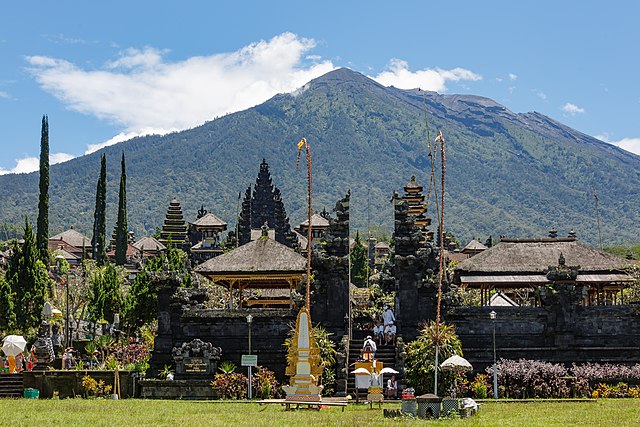印度尼西亚宗教
国别宗教概述 来自维基百科,自由的百科全书
这篇印度尼西亚宗教用来简谈印尼宗教相关的历史以及现况。

印尼在形式上是个总统制的共和国,也是个单一制国家(相对于联邦制),但实际上是种介于世俗主义和伊斯兰政权思想之间的微妙妥协产物。[2]就单一国家而言,印尼的穆斯林人口数目属世界第一,[3][4]而印尼建国哲学基础(建国五原则,Pancasila)中心思想中的第一条, 要求其公民“相信全能的上帝”。[5]因此印尼虽然日常采行的是世俗国家的做法,但无神论者在出生和婚姻登记,以及身份证发放方面会有注记,而有受歧视的情况。 [6][7][8]但亚齐特区得自主采行伊斯兰教法,当地对宗教少数和性取向少数群体的歧视性做法而有不佳的名声。[9]印尼几个穆斯林占多数的地区也有推动伊斯兰主义和伊斯兰基本教义派运动的情况。[10]
该国另有信奉不同宗教的信徒,这些人也对印尼的政治、经济和文化生活产生显著的影响。虽然印尼的宪法声称要保障宗教自由,[11]但受到印尼政府承认的宗教只有6种:伊斯兰教、基督教(其中新教与天主教各当作一种)、印度教、佛教和儒教(印尼孔教)。[12]根据印尼宪法法院在2017年所做的裁决,“信仰的分支/流派”(参见信仰分流)和透过新兴宗教运动倡导的民族宗教都必须受到承认,并且在印尼身份证 (KTP) 中注记。[13][14]根据非政府组织印尼宗教与和平会议 (Indonesian Conference on Religion and Peace,ICRP) [15]所收集的数据,印尼的非官方承认宗教约达245种。[16]
印尼法律要求公民在KTP上注记前述6种官方所承认的宗教,但也可把该栏留白。[7]印尼不承认不可知论或无神论,对官方宗教亵渎属于非法(参见印尼宗教亵渎法)。[17]在2018年的政府统计数据中,印尼人中有86.7%自称是穆斯林(其中逊尼派占约99%,[18]什叶派占约1%[19]和阿赫迈底亚派占0.2%[7])、新教7.6% 、天主教3.12% 、印度教1.74%、佛教0.77%、印尼孔教0.03%及其他0.05%。[20]
历史

在公元1世纪前,印尼原住民所依循的是南岛民族和巴布亚人的信仰和传统。[21]
从历史上看,来自印度次大陆、中国大陆、葡萄牙、阿拉伯世界和荷兰的移民一直对群岛上的宗教和文化多样性有过重要的贡献。[22]但为适应印尼本身的文化,外来的影响均做过修饰而有所变化。

在同属亚伯拉罕诸教的伊斯兰教、基督教和犹太教等抵达印尼之前,当地已受同样具有法哲学的印度教和佛教的深厚影响。后述的两个宗教约在公元2世纪和4世纪由印度商人带到苏门答腊岛、爪哇岛和苏拉威西岛。印度教中的湿婆教于公元5世纪在爪哇开始发展。印度教对由罗阇(君主、国王)个人统治的政治意识形态产生决定性的影响。[23]这种由印度商人建立的佛教系统在接下来的世纪中进一步发展,而后有几个受印度教-佛教影响的王国,如古泰王国、三佛齐王国、满者伯夷王国和夏连特拉王国在此时期建立。世界上最大的佛教寺庙群 - 婆罗浮屠即由夏连特拉王国所兴建,印度教寺庙群普兰巴南(推测建于马打兰王国,或是三佛齐王国时期)也大约在同一时期兴建。印度教-爪哇文明在14世纪的满者伯夷王国时期达到顶峰,此时期在印尼历史上被称为“黄金时代”。[24]
伊斯兰教于13世纪由印度的古吉拉特邦传入印尼群岛。[22](也有学者提出从阿拉伯半岛和波斯传入的理论[25]),首先在苏门答腊岛西海岸传播,然后往东到爪哇岛发展。此一时期有受伊斯兰教影响的王国,如淡目苏丹国、巴让苏丹国、马打兰苏丹国和万丹苏丹国的兴起和陨落。到15世纪末,已建有20个以伊斯兰教为基础的王国,反映出当时伊斯兰教在印尼的强势地位。[26]
葡萄牙人在16世纪引天主教进入印尼,特别是在佛洛勒斯群岛以及今日成为东帝汶民主共和国的所在处。[27]新教(主要是加尔文主义和路德宗)首先由荷兰人于16世纪引入。对荷兰人来说,经济利益远较宗教皈依重要,因此传教工作避开像爪哇岛以穆斯林人口为主的地区。当初负责统治印尼的荷兰东印度公司 (简称VOC) 对传教工作进行监管,以符合自己的经济利益,并将其重点放在群岛东部具有泛灵论信仰的地区,包括摩鹿加群岛、苏拉威西岛北部、努沙登加拉群岛、西巴布亚和加里曼丹。[28]基督教后来从加里曼丹的沿海港口传播,传教士进入苏拉威西岛托拉查人部落中。德国传教士路德维希·英格威尔·诺门森领导的传教活动着重在苏门答腊岛的部分地区,其中最显著的是让巴塔克人皈依,今天他们绝大部分均信奉新教。[29]
苏卡诺总统在位期间的特点是宗教与国家之间的“互不信任”。[30]而到第二任总统苏哈托的新秩序期间,这种关系发生重大变化。在1965年发生的未遂政变(九三〇事件),印尼官方正式将其归咎印尼共产党 (简称PKI) 所主导,而导致1965年-1966年大屠杀,之后苏哈托政府透过强制信奉宗教来压制PKI的支持者,因为这些人大多数是无神论者。[31]结果是印尼公民被要求在身份证上注记个人的宗教信仰。这种政策导致大规模的宗教皈依,以转向新教和天主教居多。印尼华人原本多信奉儒教。而当时此宗教尚不是国家承认的宗教,因此有许多人转而皈依基督教。[32]
国家承认的宗教

印尼伊斯兰教的历史复杂,反映出印尼文化所具有的多样性。[33]早在8世纪就有证据显示阿拉伯穆斯林商人进入印尼群岛。[33]威尼斯共和国商人和探险家马可·波罗口述,经由他人撰写的《马可·波罗游记》,其中提及在公元1297年,今日苏门答腊岛亚齐的波拉克有个由摩尔商人建立的新社区,这是已知在印尼有阿拉伯穆斯林社区的最早纪录。 [34]在15世纪和16世纪,透过毛拉纳·马利克·易卜拉欣(又名苏南·格雷西克(Sunan Gresik),原籍撒马尔罕,是瓦利松戈(九圣)中的第1人)在苏门答腊岛和爪哇岛,和中国明朝三宝太监郑和在爪哇北部的传教工作,加上当时各个苏丹国发动对印度教-佛教王国征战,以争取领土控制权,而加速伊斯兰教的传播。当时在苏门答腊岛北部和南部、爪哇岛西部和中部以及加里曼丹南部同时出现四个不同,而且互相竞争的苏丹国。这些苏丹国以伊斯兰教为国教,并与印度教徒和其他非穆斯林教徒的王国展开战争。 [26]


随后,印度教、佛教、印尼孔教、信仰泛灵论的社区和无宗教信仰者透过向穆斯林统治者缴纳吉兹亚(人头税)以换取和平,而其他人则选择皈依伊斯兰教以规避赋税。 [35]印尼的穆斯林在很多情况下都没像中东的穆斯林那么严谨。在有些地区,人们保留并延续他们的旧有信仰。他们信仰的是包含有伊斯兰教元素的综摄,[36]而有人则选择逃离,聚集在他们足以自保的岛屿社区中,例如西爪哇的印度教徒往东迁移,抵达巴厘岛和邻近小岛定居,而建立巴厘岛印度教。[37][38]142–73.</ref>
当在此段宗教冲突和各苏丹国的战争期间,新的权力中心试图整合他们所控制的领土,而欧洲殖民主义者莅临。[37]印尼群岛很快遭到荷兰殖民政府的统治。[39]殖民政府制止宗教冲突,并逐步开始发掘、理解和保存印尼(特别是在爪哇和印尼西部岛屿地区)自古即有的古印度教-佛教文化。[40]
绝大多数印尼穆斯林(约99%)信奉属于逊尼派中的沙斐仪派。有少数人跟随麦兹海布、[18][41]和萨拉菲运动[42]。目前印尼伊斯兰教有两个主要的阵营 - 传统主义和现代主义。两者都得到印尼两个最大的伊斯兰民间社会团体 - 伊斯兰教士联合会和穆哈玛迪亚的支持。[43]两阵营都认为必须运用苏菲主义的塔里卡(路径)以追寻最终的真理。[44]
苏哈托总统下台后,由于伊斯兰教在政治上的扩张,政党再次被容许鼓吹建国五原则(Pancasila)以外的意识形态。几个基于教法意识形态的伊斯兰主义政党和星月党组成的联盟(PBB)在1999年的选举中得票率排名第6。然而到2009年的选举,PBB的得票排名仅为第10,而采温和及宽容的伊斯兰教政党取得更显著的成绩,例如繁荣正义党 (PKS) 得到近8%的选票,排名第4。[45]
什叶派在早期伊斯兰教传播到苏门答腊岛和爪哇岛北部曾发挥过重要作用。[46]目前在苏门答腊岛、爪哇岛、马都拉岛和苏拉威西岛有十二伊玛目派信仰者,在巴厘岛有伊斯玛仪派信仰者,人数总共约有1-3百万,约占印尼穆斯林人口的1%以上。[47]印尼的什叶派信仰者中包含有阿拉伯裔印尼人和哈德拉毛人。 [48]主要组织是“印尼圣裔协会(印尼语:Ikatan Jamaah Ahlulbait Indonesia”(IJABI)。[49]
阿赫迈底亚派穆斯林最早传入印尼是在1925年夏天(大约是在印尼独立革命前20年),由这个派别的传教士拉赫马特·阿里 (Rahmat Ali) 进入苏门答腊岛,在亚齐的塔帕克团开始活动,初期有13名信众 。[50]这个教派在印尼的宗教发展中曾发挥过影响力,但在现代却为其他伊斯兰教机构所不容,甚至激进穆斯林团体会对这个派别采取暴力行为。[50]估计阿赫迈底亚派组织(印尼阿赫迈底亚社团(印尼语:Jamaah Muslim Ahmadiyah Indonesia)(JMAI) 中有400,000名追随者,相当于印尼穆斯林人口的0.2%,[7]分布在全国542个分支组织;但印尼宗教事务部估计,这个教派的跟随者仅约有80,000名,与独立人士估计不同。[50]印尼另有一个阿赫迈底亚派的分离主义团体 - 拉合尔阿赫迈底亚伊斯兰传播运动(Lahore Ahmadiyya Movement for the Propagation of Islam),在印尼被称为 印尼语:Gerakan Ahmadiyah-Lahore Indonesia (GAI),自1924年以来即存在于爪哇,到1980年代只有708名跟随着。[50]
印尼政府对于两个主要基督教教派 - 新教和天主教,当作两个独立的宗教给予合法宗教的承认。

新教能在印尼传播,主要是在荷兰殖民时期荷兰归正教会和信义宗传教士努力的结果。[51]荷兰归正教会一直长期努力引导印尼原住民信仰基督教,后来在19世纪,其他新教派别也陆续加入。[52]VOC为符合自己的利益,会把传教工作加以规范,将传教活动限制在印尼群岛的东部。[53]虽然前述的两个宗派最为常见,但在印尼其他地方也可见到许多其他新教的教派。[54]
在印尼某些地区,新教徒的人数已达到相当程度的少数。在2018年的人口普查中,估计总人口中有7.6%宣称自己是新教徒。苏拉威西岛有17%人口是新教徒,特别在南苏拉威西省的塔纳托拉查县和中苏拉威西省有更高的占比。此外,多达65%的托拉查人是新教徒。北苏门答腊省的巴塔克人也是信仰新教的主要群体,信徒人数约占此群体的50%。率先把新教传播给巴托克人的德国传教士路德维希·英格威尔·诺门森被称为巴塔克人的使徒,并创立巴塔克基督教新教教会(印尼语:Huria Kristen Batak Protestan。[55][56][54]
印尼华人也是新教人口的重要成员,分布在印尼各地,多数集中在主要的城市地区。 在2000年,大约有35%的华裔信奉基督教,且在年轻一代中仍继续增加中。在某些地区,整个村庄都属于同一教派,例如再临宗、基督四方福音教会、信义宗、长老宗或救世军(印尼语:Bala Keselamatan),各靠传教士的努力而达成。[54]
印尼有三个新教人口占多数的省份 - 西巴布亚省、巴布亚省和北苏拉威西省,分别占当地人口的60%、68%和64%。在巴布亚省,新教徒在巴布亚本土人口中最为普遍。在北苏拉威西省,居住在美娜多四周的米纳哈桑人在19世纪即皈依基督教。今天,大多数北苏拉威西省原住民信奉不同派别的新教,而由爪哇岛和马都拉岛迁来的移民则信奉伊斯兰教。新教信徒主要居住在北苏门答腊省、西加里曼丹省、中加里曼丹省、南苏拉威西省、西苏拉威西省、中苏拉威西省、北苏拉威西省、东努沙登加拉省、北马鲁古省、马鲁古省、西巴布亚省、巴布亚省。[57] [54]
大多数印尼新教教会均为印尼教会协会 (CCI) 会员。[58]

天主教在14世纪和15世纪,因葡萄牙人到印尼群岛做香料贸易而传入当地。其中许多葡萄牙人的目标就是传播天主教,首先在1534年从摩鹿加群岛开始。传教先驱圣方济·沙勿略在1546年至1547年间遍访群岛中各岛屿,为数千名当地人施洗。在VOC统治印尼的时期,天主教受到禁止,天主教徒的数量显著下降。荷兰人对天主教的敌意有其历史上的原因,荷兰人信仰新教,他们经过八十年战争最终从信仰天主教的宗主国西班牙取得独立。VOC加大力度在佛洛勒斯岛和帝汶东部施加限制,导致天主教徒数目很显著的减少。天主教神父受到监禁或处以刑罚,并由荷兰派来新教神职人员取代。在17世纪,扬·彼得斯佐恩·库恩担任荷属东印度总督期间,有位天主教神父因为在狱中举行弥撒而遭到处决。VOC在18世纪末破产后,荷兰天主教于1800年左右再度合法化,此后荷兰天主教神职人员一直主导在印尼的传播事务,直到印尼独立为止。[52][59]在16世纪的弗洛勒斯岛上,曾建有一拉兰图卡王国,是东南亚唯一由原住民所建立的天主教王国,第一位国王名叫洛伦佐(Lorenzo)。[60]
除弗洛勒斯岛外,中爪哇省也有相当数量的天主教徒。荷兰神父弗兰斯·范·利特于1896年抵达马格朗县的慕蒂兰区后,致力在中爪哇省传播天主教。佛兰斯神父最初进展并不顺利,到1904年,有卡利巴旺的四位爪哇族酋长要求他为当地人提供教育。在1904年12月15日,有178名爪哇族在慕蒂兰区的Semagung(靠近日惹)受洗。[61]
截至2018年,印尼人中天主教徒的占比为3.12%,数目接近新教徒占比(7.6%)的一半。[62]信徒大多居住在西加里曼丹省、巴布亚省和东努沙登加拉省。弗洛勒斯岛和西帝汶岛所在的东努沙登加拉省是印尼唯一天主教徒占多数的省份(约占总人口的54.14%)。在爪哇岛,天主教除爪哇族外,也传播到印尼华人。[52][63]在今天的佛洛勒斯岛,仍然在接近复活节时会举办天主教传统庆典,当地人称之为圣周(印尼语:Semana Santa)。仪式包括游行队伍将耶稣和圣母玛利亚(当地分别称为印尼语:Tuan Ana和印尼语:Tuan Ma)的雕像带到当地海滩,然后前往天主教拉兰图卡教区的圣母玫瑰主教座堂(Cathedral of the Queen of the Rosary)。[64]
东方基督教与新教在印尼一同被归类为印尼语:Kristen。 东正教会由印尼真正东正教徒教会代表,该教会从2019年起归由俄罗斯正教会新加坡教区管辖。
此外印尼还有东方正统教会(安提阿叙利亚正教会(印尼语:Kanisah Ortodoks Suriah)和亚历山大科普特正教会(印尼语:Coptic Orthodox Christian Church in Indonesia)[65]。

印度教文化和宗教在公元2世纪左右传入印尼群岛,后来成立的王国如古泰、马打兰王国和满者伯夷等都是以印度教-佛教为基础的王国。在爪哇岛西部有个名为萨拉卡纳迦拉的巽他族王国在公元130年左右出现。此王国是印尼群岛史上第一个有记载的印度化王国,由一位印度商人与当地巽他族公主联姻后所创立。[66]印尼最大的印度教寺庙群普兰巴南,是由统治满者伯夷王国的桑贾亚王朝所建造。满者伯夷王国在16世纪被崛起的伊斯兰苏丹国所灭亡。印尼印度教-佛教王国的兴起,以至灭亡的期间被称为印尼印度教时期。[67]
印尼的印度教具有与其他地区不同的基调。[68][69]印尼把印度教称为Agama Hindu Dharma(Agama为宗教之义,Dharma为梵语,有哲学上的“法”之义),也采行种姓制度。[70]也把南岛民族的信仰元素如崇敬香、神祇、自然神灵和已故祖先融入。并透过印尼哇扬皮影偶戏和舞蹈把印度教的宗教史诗《摩诃婆罗多》和《罗摩衍那》情节演出。在印尼的各派印度教信仰者都有许多共同信仰,印度教主要的5个基本信仰(称为Panca Srada),包括对一位全能上帝(梵,宇宙的超越本体和终极实在)的信仰,对灵魂和无数地方和祖先神灵和业力的信仰(对互惠行为法则的信仰,而非对重生和转世的信仰)。此外,印尼印度教更注重艺术和仪式,而非宗教经典、法律和信仰。[68][71]在爪哇岛的许多地区,印度教和伊斯兰教相互间有巨大影响,是导致阿邦甘(保留当地信仰的爪哇伊斯兰教徒,也称为“名义上的”穆斯林)和科贾文信仰传统发生的部分原因。[72]
根据印尼在2010年所做的人口普查,印度教徒人数为400万(占印尼人的1.7%)。[62]印尼印度教协会对此数字提出质疑,他们估计实际上的印度教徒数目多达1,800万。[73]大多数印度教徒居住在巴厘岛。苏门答腊岛、爪哇岛、龙目岛、加里曼丹和苏拉威西岛也有相当数目的印度教徒;大多数是经由印尼国内移民计划迁移到这些地区的巴厘岛移民,或者是被爪哇岛的城市,特别是雅加达都会区吸引而来的城市化巴厘岛人。在北苏门答腊省的棉兰居住的的泰米尔裔印尼人是另一重要印度教徒的集中地。[7]
有些印尼本土信仰被纳入印度教(并非所有印度教追随者都同意),例如:在加里曼丹的达雅族的卡哈林干信仰;[74]在爪哇岛腾格尔族的印度教信仰;[75]南苏拉威西省布吉人的投龙堂信仰;[76]和托拉查人的Aluk Todolo信仰。[77]

佛教是印尼第二古老的宗教,大约在6世纪传入。印尼的佛教历史与印度教的历史密切相关,一些以佛教文化为基础的王国与印度教王国大约在同一时期建立。印尼群岛曾有过强大的佛教王国,如夏连特拉王国、三佛齐王国和马打兰王国等的的兴起与衰落。印尼最初接触佛教始于公元1世纪初,经由印尼和印度之间的海上丝绸之路贸易而发生。据某些中国的文字记录,有位中国僧人在前往印度取经的途中,曾目睹位于苏门答腊岛的强盛海上王国 - 三佛齐。三佛齐也是当地的佛教学习中心。在印尼可找到一些佛教古迹,包括位于日惹的婆罗浮屠寺庙群,以及各早期佛教王国的雕像或是印尼语:prasasti(铭文)。[67]
在苏卡诺总统于1960年代中期卸任之后,印尼建国五原则(Pancasila)被重申为印尼的官方宗教政策,而此政策只承认一神论。[78]结果是Perbuddhi(印尼佛教组织(Indonesian Buddhists Organisation))创始人体正老和尚(印尼出生华人后裔,俗名Tee Boan-an[79]戴满安)提出佛教有一至尊之神,即成佛种子(印尼语:Sanghyang Adi Buddha)。他还以古爪哇语中撰写的佛教经典相关历史以及婆罗浮屠寺庙来支持其立论。[80]
在苏哈托担任总统,称为新秩序的时代,佛教依据建国五原则的精神而被认可为印尼的5种官方宗教之一。
根据2018年人口普查,信仰佛教的印尼人占比大约为0.8%,即约200万人。[62]大多数佛教徒均集中在雅加达,但在廖内省、北苏门答腊省和西加里曼丹省等也有相当数量的佛教徒。然而这个数字可能会有所膨胀,因为儒教和道教的信仰者(两种信仰在当时不被被视为官方宗教)在人口普查时会自称为佛教徒。今天印尼大多数佛教徒是印尼华人,有少数是爪哇人和巴厘岛人。印尼佛教徒遵循主要的佛教流派有大乘佛教、密宗佛教和上座部佛教。大多数印尼华人的佛教信仰会融入中国民间信仰元素,成为三教(三种信仰 - 佛教、儒教和道教的混合(印尼语:Tridharma),或是一贯道(印尼语:Maytreya)。 [81]

儒家思想起源于中国,早在公元3世纪就由中国商人带到印尼。儒家思想与其他宗教不同,演化为松散的个人信仰和行为准则,而非一种组织严谨、神学理论完整的组织,这种思想类似于一种生活方式或社会运动,而非宗教。儒家直到1900年代初期才在巴达维亚(即今日雅加达)成立一个名为印尼语:Khong Kauw Hwe (孔教会,简称(THHK)) 的组织。[82][83][84]
印尼在1945年宣布独立之后,儒学受到多次政治冲突的影响。 苏卡诺总统在1965年颁布命令(No. 1/Pn.Ps/1965),承认印尼有6种合法的宗教,包括儒教在内。1961年,印尼孔教会(印尼语:Khung Chiao Hui Indonesia,简称PKCHI)(现称印尼儒教最高委员会)宣布儒教是种宗教,孔子是这个教派的先知。 [85][84]
在继任的苏哈托总统的新秩序时期,尤其是在据称得到中国支持的印尼共产党(PKI)垮台之后,反华政策成为一种有效取得群众支持的方式。苏哈托在1976年发布备受争议的总统令(No.14/1967),禁止中国文化,包括使用中文的印刷文件、中国信仰、中国节庆活动,连中国姓名也在禁止之列。然而苏哈托也承认印尼华人虽然只占全国人口的3%,却拥有大量财富和权力。[85][84]
印尼在1969年通过法令(No. 5/1969),将6种官方许可的宗教恢复。但未实际施行。 印尼内政部部长在1978年发布指令,声称只有5种官方许可的宗教,儒教被排除在外。 在1979年1月27日的内阁会议认定儒教不是宗教。内政部长在1990年另发指令,重申印尼共有5种官方许可的宗教。.[85][84]儒教在新秩序政权时期的地位从来就不清不楚。法律之间相互冲突,上级法律不反对部儒家思想,而下级法律则不予承认。等同事实上儒家并未受到政府的承认,信徒被迫在5个官方宗教中择一选择,在身份证上登记,以保住公民的身份。这种做法应用到各方面,包括国籍登记、婚姻登记、户口登记。当时印尼的公民教育中,学童被告知该国只有5种官方宗教。[85][84]
苏哈托在1998年下台后,阿卜杜拉赫曼·瓦希德在1999年当选该国第4任总统。他将1967年总统令和1978年内政部指令撤销,儒教重新被承认为印尼的合法宗教。从事中国文化和相关活动再次受到允许。[86]
原住民信仰

印尼群岛在印度宗教(此指印度教及佛教)和亚伯拉罕诸教(此指伊斯兰教及基督教)传入之前,即已普遍存在许多与祖先相关的泛灵论/多神论的原住民信仰(南岛民族和巴布亚民族信仰)。有些仍存在于印尼某些地区(纯粹或是综摄的形式)。包括:
- 巴塔克人的帕马林信仰
- 布吉人的投龙堂信仰
- 达雅族的卡哈林干信仰
- 爪哇族的科贾文信仰
- 卡罗族的佩美纳信仰
- 马努塞拉族瑙鲁斯信仰(Naurus)(是种印度教,融合有泛灵论和新教元素的混合体。[87])
- 明打威族/萨库得族的Arat Sabulungan信仰
- 米纳哈桑族的Malesung信仰
- 尼斯岛族的Fanömba adu信仰 (Pelebegu)
- 巴布亚人(阿斯马特族等)的Adat信仰
- 桑义赫群岛人的马萨德信仰(Masade)
- 萨萨克人的维图·特鲁信仰
- 萨武族的今吉·投信仰
- 松巴族的马拉普信仰
- 巽他族/巴堆族的古巽他族信仰(Sunda Wiwitan)
- 塔劳群岛人的穆希信仰
- 托拉查人的Aluk Todolo信仰等。[88]
非官方承认的少数民族信仰,其追随者的人数高达2,000万。[14]印尼政府经常把原住民信仰视为习俗信仰(kepercayaan adat)而非宗教(印尼语:agama),是官方承认宗教的变体。也因为如此,这些信仰的追随者,如信仰卡哈林干信仰的达雅族,为避免受压力而皈依伊斯兰教或基督教,把自己认定为印度教的追随者。一些原住民部落信仰,如古巽他族信仰、托拉查人Aluk Todolo信仰和巴塔克人帕马林信仰,虽然它们与受印度影响的巴厘岛印度教不同,可能会为生存而与印度教联系,又同时与主流的巴厘岛印度教维持有所区别。在许多情况下,有些原住民信仰的追随者可能会皈依基督教或伊斯兰教,在身份证上(KTP)做此种登记,却仍持续保有既有的信仰。[89]
然根据宪法法院在2017年颁布的一项裁决,“信仰的分支/分流动”(印尼语:aliran kepercayaan),包括当地的新兴宗教,已部分获得承认。这项裁决叙明,那些要求“信仰不被承认的宗教信仰”的人 - 即原住民宗教追随者,把身份证件上的宗教栏留为空白的法律与宪法规定不符。[13][14]

科贾文信仰(Kejawèn,或写为Kebatinan,也称爪哇主义( Javanism)), 是泛灵论、印度教-佛教和伊斯兰教(尤其是苏非主义)的混合。这些信仰植根于爪哇族历史和精神主义,透过存异求同,把不同宗教的各方面做融合。 Kejawèn通常被认为崇尚神秘,这些信仰中有些变异与精神上自我控制有关。在1992年时的Kejawèn有许多流派,但这种信仰因为鼓励牺牲以供祭祀,并对当地和祖先神灵的崇敬,而普遍被引喻为泛神崇拜。这些神灵被认为附着在自然物体、人类、文物和重要的瓦里(穆斯林圣徒)的墓地。疾病和不幸事件都由这些这些神灵造成,如果祭祀或是朝圣均无法安抚神灵,则需寻求巫医来帮忙解决。Kejawèn意味人们从具有侵略性的正统伊斯兰普世主义转为更内化的普世主义。因此Kejawèn会倾向将普世与当地,还有社区和个人之间的藩篱破除。[90]
根据新加坡作者与政治家李炯才的看法,Kejawèn没特定的先知、[91]圣书,[91]也没有独特的宗教节日和仪式;这种信仰更多地与每个追随者内化的超验视野和信仰,及他们与他人和至高无上神灵的关系有关。因此这些信仰者可在身份证中注明为为6种官方认可的任何一种,但仍依循Kejawèn信仰和生活方式。这种组织松散的思想和信仰潮流在1945年的宪法中有合法地位,并在1973年被承认为尊崇一位至高无上的上帝信仰(印尼语:Kepercayaan kepada Tuhan Yang Maha Esa),在某种程度等同取得合法宗教的地位。前总统苏哈托即自诩为这种信仰的拥护者。[92]
正式的Kejawen/Kebatinan流派有修普达(Subud)、苏玛拉(Sumarah)、潘隔斯图(Pangestu)、阿玛沓运动等。[93]
修菩达由穆罕默德·苏布·苏墨哈迪维多多在1920年代创立。 而修菩达这个名字在1940年代后期,当团体经合法注册后才开始使用。修菩达运动的基础是倡导修行,通常被称为灵性修行(印尼语:latihan kejiwaan),苏墨哈迪维多多将其称为“上帝的力量(the Power of God)”或“伟大的生命力量(the Great Life Force)”的指导。 苏墨哈迪维多多的目标是依循上帝的旨意达到完美的品格。[94]只有激情、心思和意念与内心的感觉能够分开时,才能接触到无处不在的“伟大的生命力量”。[95][96][97]
苏墨哈迪维多多认为当今人们不再单纯相信文字,而需要个人证据和宗教或精神现实的证明。他声称修菩达不是种新的教义或宗教,而精神修行本身就是人类正在寻找的证据。他还拒绝把修菩达归类为kebatinan团体。今日修菩达团体在大约83个国家/地区中拥有约10,000名会员。[98]
萨明主义运动(印尼语:Sedulur Sikep)由Surosentiko Samin于19世纪末和20世纪初在中爪哇省布洛拉)所创立,倡导以和平方式对抗荷属东印度殖民者的资本主义(例如不纳税,不提供殖民者所需的柚木),但Surosentiko Samin本身为文盲,追随者多为文盲,留下的文字资料极为有限。[99]

印尼人称呼巫师/巫医为Dukun(科贾文信仰巫师,也有巫医的称法)或是pawang(帕旺(巫术))(印尼的马来族则使用bomoh的称法)。他们的社会角色是民俗大夫、通灵、民俗专家,有时是巫术和黑魔法大师。印尼有许多自封的巫师都是骗子和罪犯,专找相信超自然现象,容易上当和迷信的人下手。 [100]
其他宗教和信仰

塞法迪犹太人在17世纪由伊比利半岛的葡萄牙和西班牙迁来印尼群岛定居。[101]在1850年代,约有20个来自荷兰和德国的犹太家庭,居住在巴达维亚。有些人则住在三宝垄和泗水。有些巴格达犹太人也来印尼定居。1945年之前,约有2,000名来自荷兰的犹太人居住在印尼。在日本占领印尼期间,由于犹太人会被送往拘留所,而在印尼争取独立的民族革命期间,欧亚人会成为攻击的目标,因此有些犹太人会皈依基督教或伊斯兰教来规避风险。据报导印尼在1957年大约仍有450名犹太人,主要是在雅加达的阿什肯纳兹犹太人和在泗水的塞法迪犹太人。这个群体在1963年减少到50人,在1997进一步年降到20人。[102]
在泗水的犹太人多年来经由住在新加坡的亲戚和教友的零星捐献,一直保有一座名为Beth Shalom的犹太会堂。[103]在2009年,由于伊斯兰教激进组织抗议以色列对加沙地带的攻击(参见2008年加萨战争),Beth Shalom遭到关闭。它后来被泗水政府指定为历史建筑,但这所会堂在2013年5月于无预警的情况下遭到拆除,推测可能是某种神秘的不动产交易下的结果。[104]
自2003年以来,一座名为“Shaar Hashamayim(天堂之门)”的犹太教堂为北苏拉威西省通达诺镇约20名当地犹太人社区提供服务,约有10名犹太教正统派(哈西迪派)的教友来此礼拜。这是当前印尼唯一仍在运作的犹太会堂。[104][101]
“印尼犹太社区联合会(The United Indonesian Jewish Community)”(简称UIJC)于2009年组成,并于2010年10月开始运作。[101]2015年,第一个名为“Beit Torat Chaim”的官方犹太中心由印尼宗教事务部核准启用。此中心位于雅加达,将由拉比Tovia Singer主持。[105]
巴哈伊信仰于1863年在伊朗创立,却一直受到伊朗当局的迫害,迄今依然如此,伊斯兰世界也对这种信仰的追随者予以迫害。根据美国创立的世界宗教数据档案协会(ARDA)中针对印尼巴哈伊信仰推算的资料,印尼在2010年有22,800名信徒。[106][107]但到2015年ARDA则表示无可靠资料以供估计。[108]
在印尼的巴哈伊信仰者受到某种程度的政府歧视。[108][109]自2014年起,情况略有改善,有传说政府将承认其为合法宗教(有错误报导说印尼政府已于2014年承认)。[110][111]
锡克教徒于1870年代开始移民到印尼(商人,及担任警卫者)。苏门答腊岛和爪哇岛有几所谒师所和学校,例如有一处建于棉兰(1911年)。印尼锡克教最高委员会(Supreme Council for the Sikh Religion in Indonesia)在2015年成立。[112]印尼的锡克教信徒约有7,000人(另称介于10,000至15,000人之间[7]),由于这个宗教并未得到政府正式承认,导致信徒在身份证上注明自己为印度教徒。[113]
在印尼的锡克教属于锡克教改革运动的Radha Soami Satsang Beas派(RSSB),而非传统的正统锡克教。[114]
在雅加达印度裔印尼人中有个名为”印尼耆那教社群“(Jain Social Group Indonesia,简称JSG Indonesia)的小型组织存在。[115]
印尼最著名的新兴宗教是神智学协会,[116]超验冥想运动,[117]法轮功,[7]和两种起源于印尼的修菩达[118]和伊甸社区(Jamaah Alamulla)。 [7][119]
虽然印尼并无明文禁止无神论,但无神论者因公开表达其观点而被控亵渎先知的法律案件,而引发根据Pancasila,这样做是否实际上违法的质疑。有神职人员援引Pancasila第一原则来辩称这样做即为违法,而法律学者则表示,这项原则是世俗民族主义者、穆斯林和非穆斯林国家创始人之间的妥协,目的并非禁止无神论。虽然如此,无神论者群体往往因为害怕遭起诉而不敢公开表达他们的观点。[120][121]
在2012年,一位名为亚历山大·安的公务员因在他的Facebook页面上写下“上帝并不存在”并在网上分享有关先知穆罕默德的材料,[122][123]而引发全国性的争论,他被判处30个月监禁。[124]亚历山大的律师推测印尼只有约2,000名无神论者,但由于担心公开表达无神论观点会遭监禁,所以实际上会有多少人抱持无神论观点,则不易估计。[124]
各宗教间关系
虽然印尼政府设定几种官方承认的宗教,但不同宗教间的冲突确实会发生。在苏哈托主政的新秩序期间,他提出反华法案(参见针对印尼华人立法),与中华文化有关者一律遭禁,包括姓名和宗教。苏哈托也努力让政府“去伊斯兰化”,在内阁中任用大量基督徒阁员。然而到1990年代初期,伊斯兰化问题出现,军队分裂为民族主义阵营和伊斯兰阵营。后者由普拉博沃·苏比安托将军领导,支持伊斯兰化,而维兰拓将军则支持世俗国家。 [125]
在新秩序时期,源自荷属东印度时期即有的印尼国内移民计划仍继续实施,以便把数百万人从人口稠密,过度拥挤的爪哇岛、巴厘岛和马都拉岛迁徙到人口较少的地区,例如安汶、小巽他群岛和巴布亚。这种做法受到甚多批评,被描述为爪哇族和马都拉族的殖民,而把伊斯兰教带入非穆斯林地区。印尼西部的公民主要是穆斯林,基督徒是少数,而在东部地区,基督徒的规模与穆斯林相似或较多。这种试图平衡人口分布的做法导致东部地区出现更多的宗教冲突,包括自苏哈托总统退位之后的波索骚乱和马鲁古教派冲突的社区暴力事件。[126]
印尼政府透过提出宗教间合作计划,努力缓和紧张局势。印尼外交部与印尼最著名的伊斯兰组织伊斯兰教士联合会共同举行国际伊斯兰学者会议(International Conference of Islamic Scholars),以倡导伊斯兰温和主义(wasat ),据信可因此缓解印尼国内的紧张局势。[127]“宗教间合作对话:社区建设与和谐”会议于2004年12月6日举行。东盟国家、澳大利亚、东帝汶、新西兰和巴布亚新几内亚均派代表参加这次会议,以讨论不同宗教团体之间的合作,尽量减少印尼宗教间的冲突。[127]
但美国国际宗教自由委员会在2010年向美国国会提交的报告中仍指出有针对印尼什叶派社区的袭击,特别是在东爪哇省和马都拉岛。在马都拉岛发生的一起事件,村民包围什叶派教徒房屋并要求他们停止宗教活动,但包围者遭到当地领导人和神职人员驱散。[128]在处理非主流伊斯兰阿赫迈底亚派信徒的问题上,印尼并未采取行动以维护信徒的人权。几座阿赫迈底亚清真寺在2008年遭到烧毁。有126名阿赫迈底亚信徒在2012年之前的4年里成为印尼本国境内的难民。[129]
然而有迹象显示,为建造礼拜场所而发生的宗教冲突,与商业利益有关的成分占较大的比率。例如在雅加达全福音伯特利教会(GBIS) 的争议是由于在1957年即有的土地纠纷,而印尼长老教会(GKI) 在茂物Taman Yasmin区的争议是由于市政府计划把教堂区变为商业区。茂物的Taman Yasmin教堂受到印尼最高法院的支持和保护,但茂物市长拒绝遵守法院的裁决。[130][131]社会上也出现一种积极的合作形式,例如6个不同的宗教组织合力帮助2004年海啸的受害者。 跨信仰组织 - “印尼逊尼派和什叶派委员会”(MUHSIN)则于2011年成立。[132]
2017年,对印尼政治人物钟万学(Ahok(阿学),印尼名为Basuki Tjahaja Purnama)的亵渎审判受到国际关注。2016年,在第4届雅加达省长选举的某次竞选活动中,Ahok表示一些公民不会投票给他,因为他们受到有人利用《古兰经》Al-Ma'ida 51诗句[133]及类似变体(宣导先知不许用非伊斯兰信徒作为保护者)的人“威胁和欺骗”。之后一位名为Buni Yani大学讲师将Ahok发言片段加以编辑及散布,而引起广泛的抗议,Ahok在2017年5月因亵渎先知的罪名遭到监禁。[134]佐科·维多多总统政府的回应是取缔伊扎布特(伊斯兰解放党)的印尼分会。[135]印尼政府(特别是该国情报机构 (BIN)) 随后采取行动以遏制伊斯兰激进主义,一些宗派人士称这是对伊斯兰教的攻击。[136][137]
人口普查中关于宗教的数据
印尼在1961年、1971年、1980年、1990年、2000年、2010年和2018年的普查以及各种调查中都用到宗教信仰这个项目来收集资料。在1961年的普查中,有关宗教的数据被认为存在分歧,因此并未公布。1971年的普查中把基督教分为三个组别 - 天主教、新教和其他。而联合国1979年世界人口统计年鉴仅列出一项,即所有基督徒的集体数据。到2000年,人口普查中只分为天主教和新教两种。[138]
| 1971年[139][140] | 1980年[141][142] | 1985年[143] | 1990年[143][144][145][146] | 2000年[143][147][148] | 2005年[143] | 2010年[62] | 2018年[20] | |||||||||
|---|---|---|---|---|---|---|---|---|---|---|---|---|---|---|---|---|
| Muslim | 103.58 | 87.51% | 128.46 | 87.94% | 142.59 | 86.92% | 156.32 | 87.21% | 177.53 | 88.22% | 189.01 | 88.58% | 207.18 | 87.20% | 231.07 | 86.7% |
| Protestant | 8.74 | 7.39% | 8.51 | 5.82% | 10.59 | 6.46% | 10.82 | 6.04% | 11.82 | 5.87% | 12.36 | 5.79% | 16.53 | 6.96% | 20.25 | 7.6% |
| Catholic | 4.36 | 2.98% | 5.14 | 3.13% | 6.41 | 3.58% | 6.13 | 3.05% | 6.56 | 3.07% | 6.91 | 2.91% | 8.35 | 3.12% | ||
| Hindu | 2.30 | 1.94% | 4.76 | 3.26% | 3.18 | 1.94% | 3.29 | 1.83% | 3.65 | 1.81% | 3.70 | 1.73% | 4.01 | 1.69% | 4.65 | 1.74% |
| Buddhist | 1.09 | 0.92% | 1.60 | 0.98% | 1.84 | 1.03% | 1.69 | 0.84% | 1.30 | 0.61% | 1.70 | 0.72% | 2.03 | 0.77% | ||
| Confucian[149] | 0.97 | 0.82% | 0.95 | 0.58% | 0.57 | 0.32% | 0.41 | 0.20% | 0.21 | 0.10% | 0.12 | 0.05% | 0.07 | 0.03% | ||
| Other | 1.69 | 1.42% | 0.24 | 0.11% | 0.30 | 0.13% | ||||||||||
| Unstated | 0.14 | 0.06% | ||||||||||||||
| Not asked | 0.76 | 0.32% | ||||||||||||||
| Total[150] | 118.37 | 146.08 | 164.05 | 179.25 | 201.24 | 213.38 | 237.64 | 266.5 | ||||||||
2000年普查资料中天主教徒人数下降,原因为东帝汶脱离印尼而独立。
由于2004年12月26日亚齐省的海啸导致大量穆斯林人口死亡,而导致2010年普查资料中穆斯林人口百分比有所下降。
| 族群 | 穆斯林 | 基督徒 | 印度教徒 | 佛教徒 | 印尼孔教徒 | 其他 | 总计 | |||||||||||||||||||||||||||||||||||||||||||||||||||||||||||||||||||||||||||
|---|---|---|---|---|---|---|---|---|---|---|---|---|---|---|---|---|---|---|---|---|---|---|---|---|---|---|---|---|---|---|---|---|---|---|---|---|---|---|---|---|---|---|---|---|---|---|---|---|---|---|---|---|---|---|---|---|---|---|---|---|---|---|---|---|---|---|---|---|---|---|---|---|---|---|---|---|---|---|---|---|---|---|
| 爪哇族 | 92,107,046 | 2,428,121 | 160,090 | 90,465 | 2,857 | 9,599 | 94,788,943 | |||||||||||||||||||||||||||||||||||||||||||||||||||||||||||||||||||||||||||
| 巽他族 | 36,450,022 | 1,814 | 1,851 | 24,528 | 4,854 | 3,235 | 36,665,892 | |||||||||||||||||||||||||||||||||||||||||||||||||||||||||||||||||||||||||||
| 马来族 | 8,643,370 | 8,484 | 1,031 | 19,848 | 1,243 | 242 | 8,751,218 | |||||||||||||||||||||||||||||||||||||||||||||||||||||||||||||||||||||||||||
| 巴塔克人 | 3,738,660 | 4,707,658 | 1,476 | 9,190 | 315 | 6,305 | 8,463,604 | |||||||||||||||||||||||||||||||||||||||||||||||||||||||||||||||||||||||||||
| 马都拉族 | 7,157,518 | 7,695 | 368 | 435 | 32 | 43 | 7,166,091 | |||||||||||||||||||||||||||||||||||||||||||||||||||||||||||||||||||||||||||
| 巴达维人 | 6,607,019 | 151,429 | 1,161 | 39,278 | 1,805 | 252 | 6,800,944 | |||||||||||||||||||||||||||||||||||||||||||||||||||||||||||||||||||||||||||
| 米南佳保人 | 6,441,071 | 1,822 | 179 | 1,255 | 49 | 44 | 6,459,420 | |||||||||||||||||||||||||||||||||||||||||||||||||||||||||||||||||||||||||||
| 布吉人 | 6,348,200 | 35,516 | 26,102 | 957 | 47 | 2,395 | 6,413,217 | |||||||||||||||||||||||||||||||||||||||||||||||||||||||||||||||||||||||||||
| 万丹族 | 4,634,374 | 4,810 | 101 | 2,680 | 70 | 242 | 4,642,277 | |||||||||||||||||||||||||||||||||||||||||||||||||||||||||||||||||||||||||||
| 班加尔族 | 4,108,104 | 15,775 | 994 | 1,396 | 62 | 410 | 4,126,741 | |||||||||||||||||||||||||||||||||||||||||||||||||||||||||||||||||||||||||||
| 巴厘岛人 | 127,274 | 49,385 | 3,736,993 | 10,378 | 142 | 473 | 3,924,645 | |||||||||||||||||||||||||||||||||||||||||||||||||||||||||||||||||||||||||||
| 亚齐人 | 3,398,818 | 403 | 70 | 1,028 | 7 | 4 | 3,403,961 | |||||||||||||||||||||||||||||||||||||||||||||||||||||||||||||||||||||||||||
| 达雅族 | 1,016,697 | 2,017,870 | 12,140 | 17,502 | 568 | 154,219 | 3,218,996 | |||||||||||||||||||||||||||||||||||||||||||||||||||||||||||||||||||||||||||
| 萨萨克人 | 3,153,671 | 5,540 | 4,555 | 10,682 | 7 | 439 | 3,174,894 | |||||||||||||||||||||||||||||||||||||||||||||||||||||||||||||||||||||||||||
| 印尼华人 | 131,682 | 1,211,692 | 3,552 | 1,388,829 | 94,005 | 1,114 | 2,830,874 | |||||||||||||||||||||||||||||||||||||||||||||||||||||||||||||||||||||||||||
| 其他 | 23,057,923 | 12,436,323 | 63,909 | 73,027 | 9,422 | 117,848 | 35,758,452 | |||||||||||||||||||||||||||||||||||||||||||||||||||||||||||||||||||||||||||
| 总计 | 207,121,449 | 23,359,556 | 4,005,337 | 1,691,478 | 115,485 | 296,864 | 236,590,169 | |||||||||||||||||||||||||||||||||||||||||||||||||||||||||||||||||||||||||||
| 资料来源:[151] | ||||||||||||||||||||||||||||||||||||||||||||||||||||||||||||||||||||||||||||||||||
在2018年,根据印尼统计局的数据,印尼人口中穆斯林占86.7%、基督徒占10.72%(新教徒占7.6%,天主教徒占3.12%)、印度教徒占1.74%、佛教徒占0.77%、印尼孔教徒占0.03%和其他占0.05%。[20]
参见
参考文献
参考书目
外部链接
Wikiwand - on
Seamless Wikipedia browsing. On steroids.
